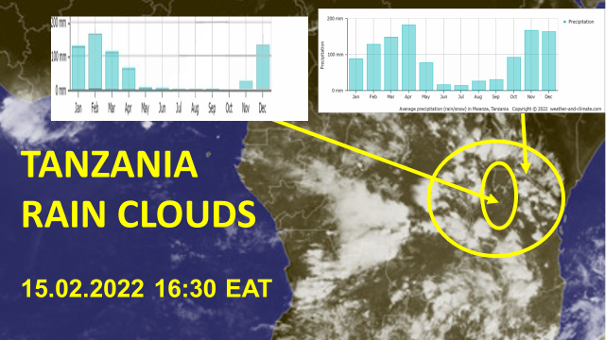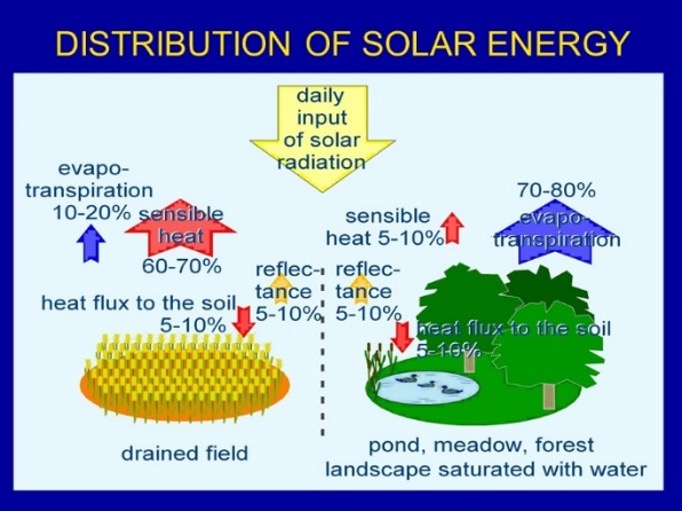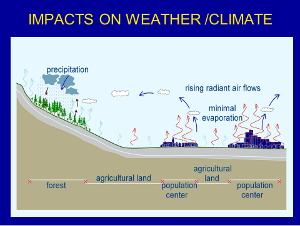Potential challenges for Tanzania’s climate recovery by changing rainwater management
One of the greatest challenges facing modern civilization is how to ensure the regeneration of natural resources that would provide sufficient natural resources for the growing population of Earth in tolerable climatic conditions. This also applies to Tanzania, with a population of over 60 million.
Recent scientific knowledge on the temporal and spatial changes in the distribution of precipitation offers a new perspective on the causes of these changes and possible solutions. If we look at the nature of the monthly precipitation in Tanzania, then in addition to the seasonality (rainy and dry seasons), there is another important territorial fact. Inland, we find that there are not only longer periods of drought, but also there is less rain overall. It rains more than 1000 mm a year in the outskirts of Tanzania and only about 600 mm inland. The period of drought in inland lasts up to 8 months, while in the peripheral parts on average 4 winter months. One could suggest that these are natural characteristics, but it is not the case.

In ancient history, rain clouds were far more horizontally formed and therefore the causes of these changes that have occurred need to be diagnosed. From the point of view of future potential and sustainable development of this rare region, it is necessary to know more about the context. This can significantly move forward not only the protection of the country’s natural resources, but also to promote long-term agricultural policy interests in favour of the food security in harmony with the environmental policy of the country. This can be achieved by supporting those system projects, in management of the the country, that strengthen the water balance in small water cycles in order to shorten the rainless season. So far, the opposite is true.
If Tanzania seeks systemic change and strengthens the country’s water resources on an ecosystem basis, then the damage to the country’s inland part can be eliminated and the recovery processes of much of the damaged Tanzania can be started. If Tanzania’s policy continues in the old water paradigm[1], in the future it will increase the country’s economic development risks in direct proportion to the loss of fertility, biodiversity and overheating of the country.
By reducing the water balance of the area, in the central part of Tanzania there will be an even greater decrease in precipitation with prolongation of the rainless season and, of course, with a more frequent occurrence of intense downpours with extensive flood damage. This will cause an increase in drought and a loss of fertility in even more of the territory than it currently is. With drought, weather extremes also grow ,with the increase in extreme torrential rains and the more frequent occurrence of extensive floods. This is associated with further soil degradation and loss of fertility.
These changes are due to heat distribution in the country. From more dried land, less water evaporates and instead of evaporated water and latent heat production, noticeable heat is produced. That changes the Bowen ratio. As the landscape dries out, the Bowen ratio[2] increases and changes the pressure conditions in the atmosphere. Therefore, in those areas where the Bowen ratio increases, precipitation totals are declining because less solar energy is consumed for noticeable heat and vice versa.

The lower the Bowen ratio, the more solar energy is transformed into latent heat and it is carried to the upper atmosphere, and there, after condensation of water vapor and dew point formation time, water vapor precipitates and rains. The interior of Tanzania needs more rain. This can be achieved just by reducing the Bowen ratio. The latter will strengthen the biotic pump[3], which will build up the formation of horizontal precipitation and thus it is possible to anticipate a reduction in the occurrence of dramatic extreme torrential rains, which often have devastating effects with the formation of massive floods.
We know very well that water returns in a small water cycle about once every 8 days. Water in a large water cycle rotates once every 3 months. We also know that the water that evaporates through the vegetation and forms clouds after condensation in the cold layers of the atmosphere returns to Earth in the form of rain at the dew point. This cycle is repeated countless times and thus ensures a permanent renewal of life on Earth. In interaction with the energy of the Sun and the carbon cycle, it is the most ingenious “factory” of the birth of all living things through photosynthesis. This is what nature and man need for their lives.
If we have a detailed look at Tanzania, we see that the country would be able to consume more water. The question is whether it is possible to solve this deficit. By changing the use of land so that small water cycles are renewed and higher precipitations take place also inland, it is possible to strengthen not only the hydromorphism of arid areas, but also the more frequent occurrence of rain.
The rainless season also brings other risks that limit Tanzania’s natural, climatic, social and economic environment. While it rains more and heavier in the outskirts of Tanzania, it rains the least inland, causing the country to suffer from water shortages and overheating. This is because overheating the dried land creates large heat islands in the boundary layer of the atmosphere, which do not allow the moist air masses from the sea to travel to the mainland and at the same time very little water evaporates. Moreover, even this little water that evaporates is shifted in the atmosphere to colder regions[4] of the country due to the functioning of the biotic pump, so it rains more and more intensively in these parts of the country.


This means that by damaging the landscape, one empties small water cycles, which increases the temperature of the landscape and the uneven occurrence of precipitation activity. This is true in all parts of the world where the country has changed. Amongst the causes are: long-term drying up of such areas with a gradual decrease in precipitation, loss of fertility, loss of biodiversity and the transformation of the green landscape into a desert. This is what most likely happened 5,500 years ago in the Sahara region. Here, the process of transformation of the green landscape took 500 years.
African countries can not only stop these degradation processes, but also start their recovery. One of the efforts is to plant trees in the Great Green Wall across the Sahara to stop the spreading of the desert by planting millions of trees. These trees need water to survive. From this point of view, a number of risks arise for this plan, which are related to the chance of survival of seedlings planted in the dry period, which lasts for more than half a year in this area.
If we start from the physics of solar energy distribution, it is evident that rainfall decreases with the increase of overheating of the country by drought, so concentrating on planting trees in an area where half a year does not rain is a job with little chance of success. The large green wall that is forming in the area where precipitation reaches barely 400 mm is proof of how this should not be done. A much more effective way is to develop a comprehensive revitalization of the country from those parts of Africa where it is raining more and where there are flood risks. If water retention measures were implemented and combined with the use of organic fertilizer in the region of Tanzania, the damaged landscape could be restored very quickly, which would trigger the fertilization of large inhospitable areas and the recovery of the climate.
Ecosystem retention of rainwater in a country that drains large amounts of rainwater with organic fertilisers each year will enhance the fertility of that part of the territory, enhancing food security and economic growth, healing the climate, increasing water resources and fertile land.
It will cool the country so much that the biotic pump will be strengthened with a paradoxically gentler suction of moist frontal systems from the Indian Ocean into the interior of Tanzania. With the support of the renewal of small water cycles, of course. This is linked to the return of lost rain even in the months when it is not raining at the moment. Through systematic planning and implementation of the restoration of the damaged landscape in the central part of the country of Tanzania, it is possible to fertilize more than 100,000 square kilometers of sparsely fertile land in the long run. Maybe more is possible, but it is necessary to make a thorough inventory of the state of the country with the definition of the possibility. The principles of this solution are described in the New Water Paradigm of 2007[1].
We estimate that within 10 years this would increase inland rainfall by at least 100 mm per year and would extend soil fertilisation in inhospitable parched land and halt further degradation. As much as 1 million people in Tanzania could work on such a program. Their work would bring a whole new perspective to economic development based on the regeneration of natural resources. The green economy could develop fully in Tanzania. The benefit of this solution will be the long-term fertilisation of the soil by storing carbon in the soil. More than 500 million tonnes of CO2 present in the atmosphere is needed for photosynthesis. We estimate that after the implementation of the entire plan, more than 150 million tonnes of pure carbon would enter the soil through photosynthesis.
If African countries came together and acted similarly in a coordinated manner, they could gradually fertilize the land and restore the inhospitable territories of Africa. It is a great challenge for Tanzania to set an example for other African countries on how to restore lost rain.
The world is on the brink of fundamental change. Regenerate what previous generations have deteriorated. We have a choice. Stay in the old paradigm and continue conflicts over natural resources, or take the path of restoring the resources we have lost. This is also a challenge for Tanzania, African countries and countries around the world, which are suffering from the water, food, environmental, social and climate crises.
Michal Kravčík, WaterHolistic, Ltd., Košice, Slovakia
[1] New Water Paradigm, 2007, www.waterparadigm.org
[2] https://experimental-hydrology.net/wiki/index.php?title=Evapotranspiration_(Bowen_Ratio)_-_Psychrometer
[3]https://www.researchgate.net/publication/26454382_Biotic_pump_of_atmospheric_moisture_as_driver_of_the_hydrological_cycle_on_land
[4]Here, the 2nd thermodynamic theorem applies, which means that heat propagates from the source.
